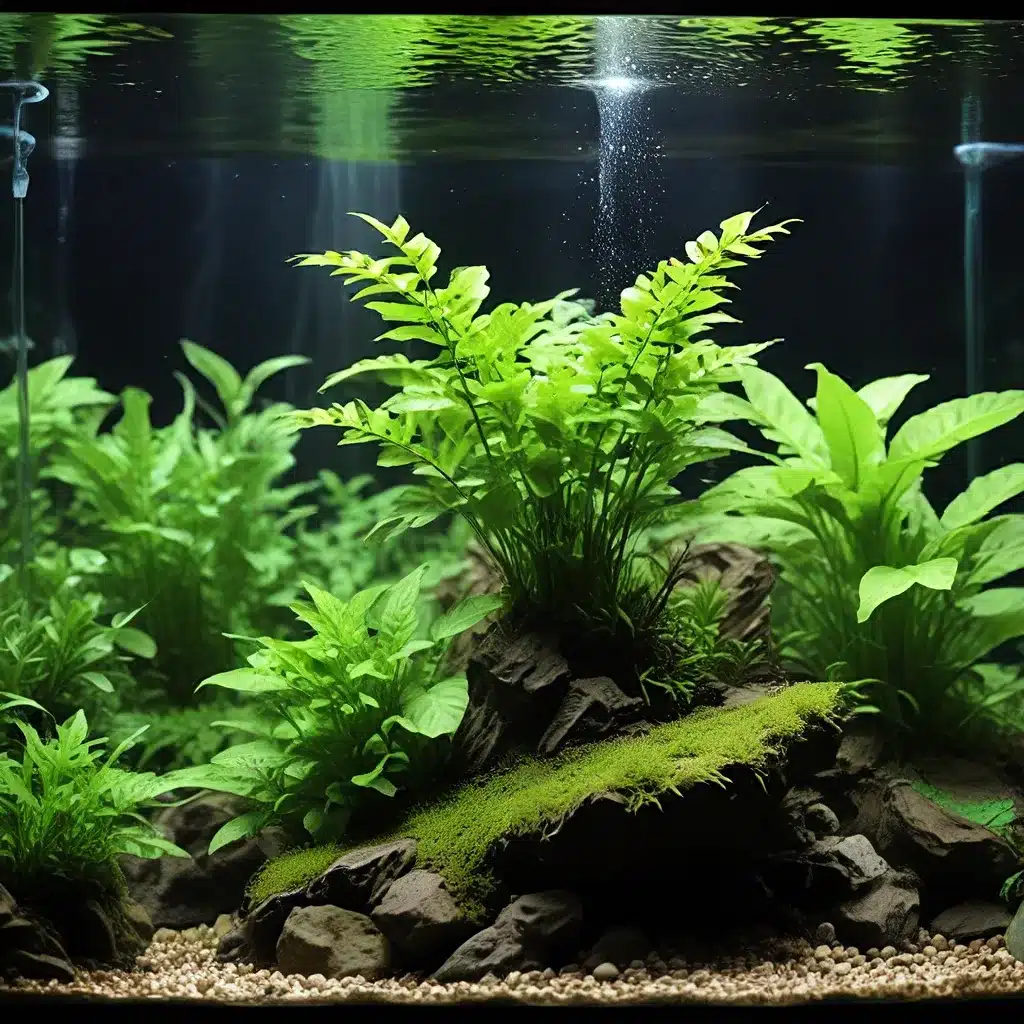
Optimizing Lighting for Vibrant Aquarium Plants
Achieving the right balance of lighting is essential for the health and growth of aquarium plants. Too much or too little light can lead to a variety of issues, from algae outbreaks to stunted plant growth. In this comprehensive guide, we’ll explore effective lighting strategies to help you create a thriving underwater oasis.
Understanding the Role of Light in Aquariums
At the heart of a successful planted aquarium lies the delicate interplay between light, nutrients, and carbon dioxide (CO2). Plants rely on light energy to undergo photosynthesis, which is the process of converting CO2 and water into glucose and oxygen. This process not only fuels the plants’ growth but also helps maintain a balanced ecosystem in your aquarium.
Proper lighting is crucial in providing the right conditions for your aquatic plants to thrive. Factors such as light intensity, spectrum, and photoperiod (the duration of light exposure) all play a crucial role in determining the overall health and appearance of your aquarium plants.
Assessing Your Lighting Needs
The lighting requirements for your aquarium plants will depend on several factors, including the plant species, the size of your tank, and the overall design goals you have in mind. Some plant species are more light-demanding than others, and understanding their specific needs is the first step in creating a balanced lighting setup.
For example, low-light plants like Java Fern and Anubias may only require a few hours of moderate lighting per day, while high-light plants like Rotala and Glossostigma will need significantly more intense and prolonged lighting. By matching the right plants with the appropriate lighting conditions, you can ensure their long-term health and vibrant growth.
Choosing the Right Lighting Equipment
Once you’ve assessed your lighting needs, it’s time to select the appropriate lighting equipment. The two most common types of aquarium lighting are LED (light-emitting diode) and T5 fluorescent lighting. Each has its own advantages and considerations:
| LED Lighting | T5 Fluorescent Lighting |
|---|---|
|
– Highly energy-efficient, with lower electricity costs – Customizable color temperature and spectrum – Longer lifespan, with minimal maintenance – Excellent for high-tech planted aquariums |
– Provide a wide range of color temperatures – Generally more affordable than LEDs – Suitable for both low-tech and high-tech setups – Require regular lamp replacements |
When choosing your lighting, consider factors like the size of your aquarium, the plant species you’ll be keeping, and your budget. It’s often helpful to consult with experienced aquarists or seek advice from reputable aquarium suppliers to ensure you select the right lighting system for your needs.
Implementing Effective Lighting Strategies
Once you have the appropriate lighting equipment, it’s time to put it into practice. Here are some strategies to help you achieve the perfect lighting balance:
-
Adjust Lighting Intensity: Gradually increase or decrease the light intensity to find the sweet spot that allows your plants to thrive without encouraging excessive algae growth.
-
Optimize the Photoperiod: Experiment with the duration of light exposure, starting with around 8-12 hours per day and adjusting as needed. Some plants may benefit from a midday break or a gradual dimming at the end of the day.
-
Utilize Reflectors and Diffusers: Strategic placement of reflectors can help maximize the efficiency of your lighting, while diffusers can create a more even distribution of light throughout the aquarium.
-
Supplement with CO2 and Nutrients: Providing adequate levels of CO2 and essential nutrients, such as nitrogen, phosphorus, and potassium, will help your plants utilize the available light more effectively.
-
Monitor and Adjust: Regularly observe your aquarium and make adjustments to the lighting, CO2, and nutrient levels as needed. Be patient and allow time for your plants to acclimate to any changes.
By implementing these lighting strategies, you’ll be well on your way to creating a lush, vibrant aquarium that showcases the natural beauty of your aquatic plants. Remember, finding the perfect balance is an ongoing process, so don’t be afraid to experiment and fine-tune your approach to achieve the desired results.
Troubleshooting Common Lighting-Related Issues
Despite your best efforts, you may encounter some challenges along the way. Let’s explore some common lighting-related issues and how to address them:
Algae Outbreaks
Excessive algae growth can be a frustrating problem, often caused by an imbalance in lighting, nutrients, or CO2 levels. If you notice an algae outbreak, try reducing the lighting intensity or duration, ensuring proper nutrient dosing, and maintaining consistent CO2 levels.
Stunted Plant Growth
If your plants are not growing as vigorously as you’d like, it could be due to insufficient lighting. Gradually increase the light intensity or duration, making sure to monitor for any signs of stress or algae. Ensure that your plants are receiving adequate nutrients and CO2 as well.
Color Variations and Leaf Deformities
Certain plant species may exhibit color changes or leaf deformities when exposed to improper lighting conditions. Adjust the light spectrum, intensity, or photoperiod to find the optimal settings for your specific plant species.
Hot Spots and Uneven Lighting
Hotspots, areas of the aquarium receiving significantly more light than others, can lead to localized algae growth and plant stress. Use reflectors, diffusers, or adjust the placement of your lighting fixtures to achieve a more even distribution of light throughout the aquarium.
By addressing these common issues and continuously optimizing your lighting setup, you’ll be able to create a thriving, low-maintenance aquarium that showcases the natural beauty of your aquatic plants.
Conclusion
Lighting plays a pivotal role in the success of any planted aquarium. By understanding the specific needs of your aquatic plants and implementing strategic lighting techniques, you can create a vibrant, healthy underwater ecosystem that will captivate both you and your guests.
Remember, finding the perfect lighting balance is an ongoing process, and it may take some experimentation to determine the ideal settings for your aquarium. Embrace the journey, be patient, and enjoy the rewarding experience of nurturing a flourishing planted aquarium.
Happy aquascaping!

